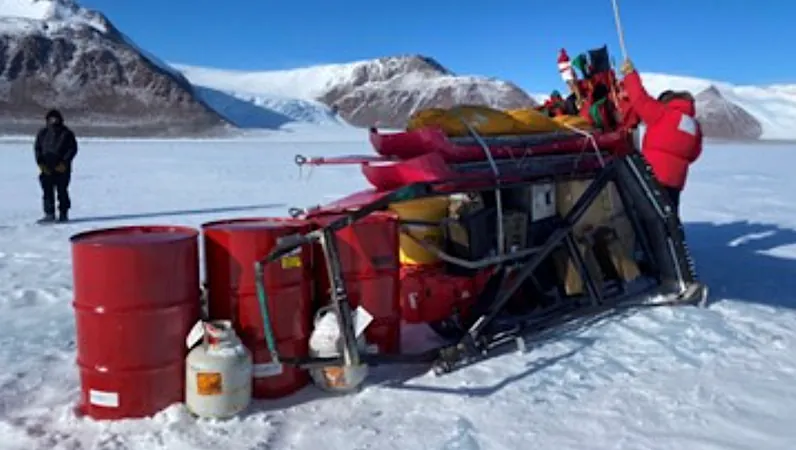
James Webb Telescope's Urgent Mission Unveils Secrets of the 'City-Killer' Asteroid 2024 YR4 Ahead of 2032 Encounter
2025-03-31
Author: Yu
Introduction
In a groundbreaking move, the James Webb Space Telescope (JWST) has executed its first observation of the notorious "city-killer" asteroid known as 2024 YR4. This massive space rock is poised for a dangerously close approach to Earth and the moon in December 2032, prompting scientists to take swift action.
Observations and Discoveries
The observatory's emergency time allocated to an international research team allowed them a glimpse of 2024 YR4, revealing that it may be larger and has a rockier composition than previous assessments from ground-based telescopes suggested. Fortunately, JWST confirmed a crucial piece of information: there’s no longer any threat of collision with Earth during its December 2032 pass. However, researchers still warn that a direct impact with the moon cannot be entirely ruled out.
Preliminary Report Findings
As detailed in the latest preliminary report—yet to undergo peer review—the scientists indicated, “While an Earth impact by 2024 YR4 has been ruled out, there remains a non-zero probability of impacting the Moon.” A follow-up observation is scheduled for May 2025, which will further refine the asteroid’s trajectory before it disappears from view for several years.
History of 2024 YR4 Detection
Asteroid 2024 YR4 was first detected in December 2024. Initial assessments indicated it to be about 180 feet (55 meters) in diameter—comparable in height to the Leaning Tower of Pisa. Its orbital path frequently intersects with Earth's, previously giving it an estimated 3.1% chance of collision—the highest probability recorded for such an asteroid size. Following further observations, NASA recalibrated that risk down to 0% for Earth, but concerns lingered for a potential lunar strike.
Role of JWST's Infrared Sensors
JWST's infrared sensors played a crucial role in understanding this asteroid, detecting its emitted heat and leading to new insights about its size and make-up. Ground-based observatories, limited to visible-light detection, often miss crucial data regarding the physical characteristics of asteroids.
Size and Composition Insights
The analysis indicated that 2024 YR4 may actually be about 200 feet (60 meters) wide, cooler than expected for its classification. Such insights suggest it is composed of harder materials than initial perceptions indicated. The JWST observed the asteroid rotating once every 20 minutes, providing critical data on its brightness converted to mid-infrared wavelengths.
Potential Impact on the Moon
While the asteroid's size presents no immediate danger to Earth, there remains approximately a 2% chance of it impacting the moon in 2032, according to astronomer Andrew Rivkin from Johns Hopkins University. This potential event could offer a unique opportunity for scientists; observing a known asteroid create a lunar crater in real time would be unprecedented.
Expert Opinions
Experts, like physicist Alan Fitzsimmons of Queen’s University Belfast, express enthusiasm for the possibilities an impact could bring: "It would have no effect on Earth but would provide invaluable insights into the formation of lunar craters."
Looking Ahead
With the vital May 2025 observations on the horizon, astronomers eagerly anticipate gaining further clarity about the asteroid’s trajectory and its implications for the moon. The world will likely be watching closely, not just for the safety concerns but for the scientific revelations this cosmic encounter may bring.



 Brasil (PT)
Brasil (PT)
 Canada (EN)
Canada (EN)
 Chile (ES)
Chile (ES)
 Česko (CS)
Česko (CS)
 대한민국 (KO)
대한민국 (KO)
 España (ES)
España (ES)
 France (FR)
France (FR)
 Hong Kong (EN)
Hong Kong (EN)
 Italia (IT)
Italia (IT)
 日本 (JA)
日本 (JA)
 Magyarország (HU)
Magyarország (HU)
 Norge (NO)
Norge (NO)
 Polska (PL)
Polska (PL)
 Schweiz (DE)
Schweiz (DE)
 Singapore (EN)
Singapore (EN)
 Sverige (SV)
Sverige (SV)
 Suomi (FI)
Suomi (FI)
 Türkiye (TR)
Türkiye (TR)
 الإمارات العربية المتحدة (AR)
الإمارات العربية المتحدة (AR)